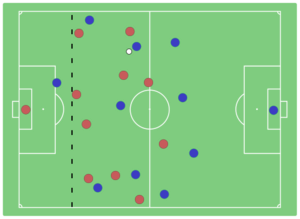Offside (sport) facts for kids

Offside is a rule used by several different team sports regulating aspects of player positioning. It is particularly used in field sports with rules deriving from the various codes of football, such as association football, rugby union and rugby league, and in similar 'stick and ball' sports e.g. ice hockey, broomball, field hockey and bandy.
Contents
Purpose of offside rules
Offside rules are generally designed to ensure that players play together as a team, and do not consistently position one or a few players near the opponent's goal ('goalhanging') to try to receive a "Hail Mary pass" for an easy goal without opposing players nearby. However, the application and enforcement of offside rules can be complicated, and can sometimes be confusing for new players as well as for spectators.
History
The word "offside" comes from a military term for a man trapped behind enemy lines, where he is said to be "off the strength of his side". Offside rules date back to codes of football developed at English public schools in the early nineteenth century. These offside rules were often much stricter than in modern games. In some of them, a player was "off his side" if he were merely standing in front of the ball. This was similar to the current offside law in rugby, which penalizes any player between the ball and the opponent's goal. By contrast, the original Sheffield Rules had no offside rule, and players known as "kick throughs" were positioned permanently near the opponents' goal.
Offside rules in different sports
- Offside (American and Canadian football)
- Offside (association football)
- Offside (bandy)
- Offside (ice hockey)
- Offside (rugby)
See also:
- Offside (field hockey)—Historically a part of the sport, but officially abolished in 1998
Notable sports without an offside rule
While most football and 'goal' sports have developed an offside rule, two codes, Australian rules football and Gaelic football, notably do not have one. A consequence in these sports, (and also hurling, camogie and basketball which have no such offside rule), is a strong tendency to tactical man-marking, where each player closely marks, and is marked by, his opposing number throughout the game.
Sports without an offside rule include:
- Australian rules football
- Gaelic football and Hurling
- 'Short-sided' versions of association football with fewer than 11 players a side, including futsal, beach soccer, five-a-side football, and indoor soccer
- Basketball—with just five players, a team with one player significantly ahead of the opposing team can be easily scored against by the other team. However, some players and teams try this strategy, known as cherry picking, in an attempt to gain an advantage by scoring easy baskets, with varying degrees of success. There is also a three seconds rule ("3 in the key") which helps prevent players from lingering near the opposing basket, effectively creating a soft offside line around the key.
- Field hockey since 1998.
- Ringette
- Rinkball
- Net sports such as volleyball and tennis—the net acts as a barrier between the opposing teams or players. However, volleyball does have rules about which players can "spike" the ball (hit it downward when it is above net height) and where.
- Squash and racquetball—opposing players are often very close to each other and a "let" may be called if a player interferes with an opposing player's ability to have a fair chance to hit the ball.
- Floorball


